duets: alto flute and piano
-
Mozart - Concerto in D Major - Alto Flute
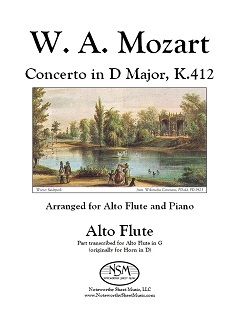 Concerto in D Major, K.412, by W. A. Mozart
Concerto in D Major, K.412, by W. A. Mozart Transcribed (from horn and piano arrangement) for Alto Flute by C.A.Vater
Alto Flute Part, PDF $3.99
Mozart's Concerto for Horn in D major for Horn and Orchestra is scored for solo horn in D, with two oboes, two bassoons, and strings. Henri Kling (1842-1918), horn player, composer, conductor, and professor, arranged the concerto for horn and piano. We used the Kling arrangement as the source from which to create a transcription of the horn part for alto flute. The piano scoreis in the public domain and available as a free pdf download from other sources such as imslp.org/.
The Concerto in D major, K.412 is a short work of approximately 8-10 min duration, consisting of only two movements - an Allegro and a Rondo Allegro. The movements are light and joyous, and pose no particular technical challenges to the alto flute player. The written range is quite limited, extending only from D5 to E6. Thus, this piece can be played by less advanced students as well as by more experienced alto flutists.
Alto Flute part, 4 pages of music; Total, 8 pages.
Preview -
Bloch - Petite Fantaisie Hongroise - Pf & Afl
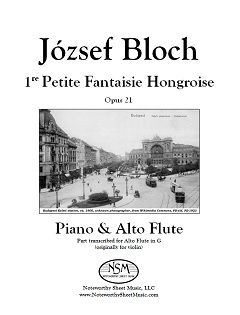 Petite Fantaisie Hongroise No.1, Op.21, by J. Bloch
Petite Fantaisie Hongroise No.1, Op.21, by J. Bloch Transcribed for Alto Flute and Piano by C.A.Vater
Piano Score and Alto Flute Part, PDF $5.99
József Bloch (1862-1922) was a Hungarian violin virtuoso, composer, and professor at the National Academy of Music and the National Conservatory (www.jewishencyclopedia.com). His Petite Fantaisie Hongroise No.1, Opus 21, was written for piano and violin and published by Bárd, ca. 1901. We thought this piece would work beautifully on alto flute, so we created a transcription of the violin part. In the range written for the Petite Fantaisie Hongroise, the alto flute may evoke the dark, mournful tone of the modern tárogató, which is often referred to as the Hungarian national instrument. We provide both our transcribed alto flute part and a re-notated edition of the piano score.
Alto Flute part, 3 pages; Piano Score, 6 pages; Total, 12 pages.
Preview
=================================
For those who would prefer to purchase a professionally-printed hard copy of this piece, rather than the PDF download offered above, our print edition of the Bloch Petite Fantaisie Hongroise No.1, Op. 21 transcribed for Piano & Alto Flute is available directly from NSM for $13.49 plus a $5.95 shipping and handling fee to addresses in the USA. Use the Contact Us form to let us know which hard copy publication(s) you would like to purchase, along with your email contact information and USPS mailing address. We will then send you a PayPal invoice for the sale and, once we receive notice from PayPal that you have paid for the item(s), we will ship your music to the address provided.
-
Mozart - Sonata in G Major - Alto Flute
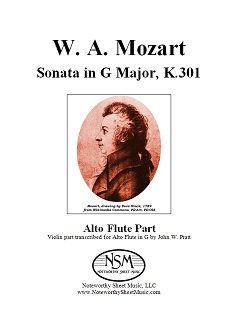 Sonata in G Major, K.301, by W. A. Mozart
Sonata in G Major, K.301, by W. A. MozartTranscribed for Alto Flute and Piano by John W. Pratt
Alto Flute Part, PDF $4.99
This sunny sonata has two movements, an up-beat Allegro con spirito followed by an Allegro that is actually a sprightly minuet with a trio section in the minor, almost as near to a Beethoven scherzo as a Haydn minuet. The violin leads as often as the piano, including at the beginning and throughout the trio, but is largely spared Mozart's typical keyboard passage work. As with six other violin sonatas composed in 1778, the first of Mozart's maturity, the violin part rarely makes significant use of double stops and is in general very well suited to alto flute. In fact, K.301 was begun with flute in mind. We provide our transcribed alto flute part. The piano score is available in the public domain as a free pdf download from imslp.org/.
For additional information about the seven Mozart Mannheim sonatas and their alto flute transcriptions, please read the Mozart’s Mannheim Sonatas article written by Mr. Pratt; the article was originally published by Flute Focus and subsequently republished by NSM on our Resources – Reviews and Articles page.
Alto Flute part, 4 pages; Total, 6 pages.
Preview -
Mozart - Sonata in E-flat Major, K.302 - Alto Flute
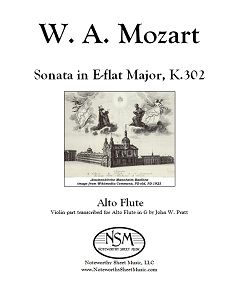 Sonata in E-flat Major, K.302, by W. A. Mozart
Sonata in E-flat Major, K.302, by W. A. MozartTranscribed for Alto Flute and Piano by John W. Pratt
Alto Flute Part, PDF $4.99
Mozart's Sonata in E-flat Major, K.302 has two movements, an Allegro and a rondo Andante grazioso. This ebullient sonata opens with a striking call to attention, much used later, which descends on the tonic triad but alternates half and quarter notes in 3/4 time, thus avoiding both square rhythm and repeated root positions on every down beat. The theme which follows is contrastingly gentle. The second movement offers a firmly forward-moving theme whose immediate repeat and final returns are variously and charmingly re-orchestrated. (excerpted from JWP's foreword to the edition)
We provide our transcription of the violin part for alto flute; the piano score is available in the public domain as a free pdf download from imslp.org/.
For additional information about the seven Mozart Mannheim sonatas and their alto flute transcriptions, please read the Mozart’s Mannheim Sonatas article written by Mr. Pratt; the article was originally published by Flute Focus and subsequently republished by NSM on our Resources – Reviews and Articles page.
Alto Flute part, 5 pages; Total, 8 pages.
Preview -
Mozart - Sonata in C Major, K.303 - Alto Flute
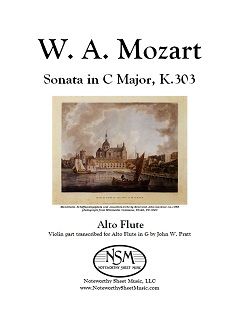 Sonata in C Major, K.303, by W. A. Mozart
Sonata in C Major, K.303, by W. A. MozartTranscribed for Alto Flute and Piano by John W. Pratt
Alto Flute Part, PDF $4.99
Both movements of Mozart's Sonata in C Major, K.303 are quite different from others of his 'Mannheim' set. The unusual first movement is in sonata form mixing retro and novel features—the whole first subject and transition to the dominant are adagio and considerably varied in the recapitulation, and there is no development. The second movement is an old-style minuet (without trio), ending with a pedal point terminating in a tremble. Our transcription for alto flute shifts the violin part to a different octave in three short segments and we have substituted musically appropriate alternatives for the double stops. We provide our transcription of the violin part for Alto Flute in G; the piano scoreis available in the public domain as a free pdf download from imslp.org/.
Alto Flute part, 5 pages; Total, 8 pages.
Preview -
Haydn - Adagio from Sym. No.24 - Afl & Pf
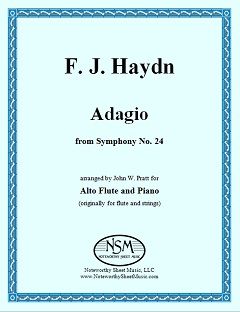 Adagio from Symphony No.24, by F. J. Haydn
Adagio from Symphony No.24, by F. J. HaydnArranged for Alto Flute and Piano by John W. Pratt
Alto Flute Part and Piano Score, PDF $6.00
We offer a flute and piano edition of the gorgeous second movement Adagio for solo flute accompanied by strings from Haydn's Symphony No.24. An arrangement for alto flute that is mellower than that for flute but also extremely beautiful is obtained by lowering the pitch a minor third. Haydn's flute part needs no other change, nor does the cadenza that was written by Mr. Pratt for our C-flute edition. The string parts have been adapted to piano sonority in a number of ways, as well as transposing them in this alto flute edition.
Alto Flute part, 2 pages; Alto Flute & Piano score, 4 pages; Total, 10 pages.
Preview -
Mozart - Sonata in A Major, K.305 - Alto Flute
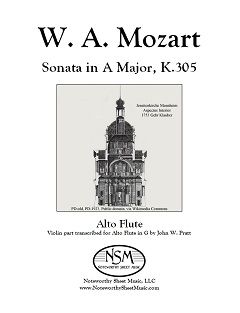 Sonata in A Major, K.305, by W. A. Mozart
Sonata in A Major, K.305, by W. A. MozartTranscribed for Alto Flute and Piano by John W. Pratt
Alto Flute Part, PDF $3.99
Mozart's Sonata in A Major, K.305 is perhaps the most completely extroverted of the Mannheim sonatas. Like K.302, it opens with four emphatically tonic bars, followed by a gentle, linear four-bar theme, all immediately repeated. The second movement of K.305 is the only movement of the Mannheim sonatas in theme-and-variations form. It is far from routine. The theme has an unusual variety of rhythms and accompaniment figurations; the 32nd-note variation is the very first, not a later one; the minor variation is at the prevailing tempo, not slow; and a brief but telling piano cadenza interrupts the antepenultimate variation's peroration. (excerpted from JWP's foreword to the edition)
We provide the transcribed alto flute part—the piano scoreis available in the public domain as a free pdf download from imslp.org/.
Alto Flute part, 4 pages; Total, 6 pages.
Preview -
Mozart - Sonata in D Major, K.306 - Alto Flute
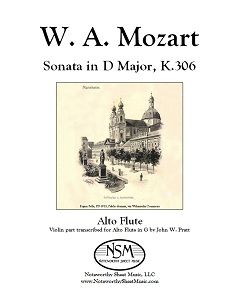 Sonata in D Major, K.306, by W. A. Mozart
Sonata in D Major, K.306, by W. A. MozartTranscribed for Alto Flute and Piano by John W. Pratt
Alto Flute Part, PDF $9.99
Mozart's Sonata in D Major, K.306 is by far the longest and showiest of the 'Mannheim' sonatas, with three large-scale movements, some quasi orchestral textures, much doubling, and brilliant passage work. The first movement's development expands four transitional bars of the exposition into a far-reaching harmonic excursion. The recapitulation begins with the second subject and returns to the first so late it amounts to a coda, the only instance of 'mirror' sonata-form in the Mannheim set. In contrast, the second movement, Andante cantabile, has a structurally orthodox sonata form, compressing and ornamenting the themes in the recapitulation, as befits the tempo. The finale is an elaborate rondo alternating between allegretto in 2/4 and allegro in 6/8. (excerpted from JWP's foreword to the edition)
We provide our transcribed alto flute part; the piano scoreis available in the public domain as a free pdf download from imslp.org/.
Alto Flute part, 10 pages; Total, 12 pages.
Preview -
Mozart - Sonata in C Major, K.296 - Alto Flute
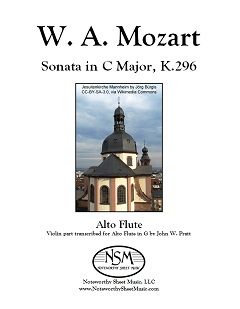 Sonata in C Major, K.296, by W. A. Mozart
Sonata in C Major, K.296, by W. A. MozartTranscribed for Alto Flute and Piano by John W. Pratt
Alto Flute Part, PDF $6.99
Mozart composed K.296 in 1778 under the same creative impulse as the other Mannheim violin sonatas, K.301‒306, but published it later, in 1781, with five other three-movement sonatas. He dedicated it to his Mannheim landlord's 15-year old daughter, Therese-Pierron Serrarius, who perhaps inspired the turns lightening the opening fanfares, quick trills in the first theme, and contrasting textures and sparkling interplay between the instruments in the first movement. The second movement is a beautiful arietta with wonderful opportunities for the alto flute to both present and accompany the melody. In the concluding Rondo, in sonata-rondo form, the instruments repeatedly swap the theme and much of the episodic material. ―J. W. Pratt
We provide our transcription of the violin part for alto flute; the piano score is available in the public domain as a free pdf download from imslp.org/.
For additional information about the seven Mozart Mannheim sonatas and their alto flute transcriptions, please read the Mozart’s Mannheim Sonatas article written by Mr. Pratt; the article was originally published by Flute Focus and subsequently republished by NSM on our Resources – Reviews and Articles page.
Alto Flute part, 7 pages; Total, 10 pages.
Preview -
Schubert - Sonatas, Op.137 - Alto Flute
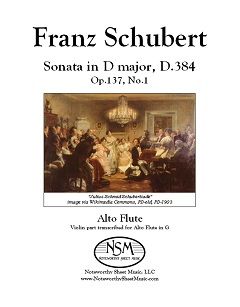 Sonatas, Op.137, by F. Schubert
Sonatas, Op.137, by F. SchubertTranscribed for Alto Flute and Piano by C. A. Vater & J. W. Pratt
No.1, Sonata in D major, D.384, Alto Flute Part, PDF $5.99
No.2, Sonata in A minor, D.385, Alto Flute Part, PDF $7.99
No.3, Sonata in G minor, D.408, Alto Flute Part, PDF $5.99
Franz Schubert (1797-1828) wrote his three violin sonatas Opus 137 when he was barely 19. They were published posthumously as 'Sonatinas', perhaps for marketing reasons, but they are full-scale sonatas in traditional classical style and format, the first having three movements and the others four. These plus the violin sonata in A of the next year constitute fully half of Schubert's known works for piano and solo instrument.
Schubert's Op.137 sonatas are truly delightful, and we have adapted the violin parts for alto flute. Where appropriate, changes have been introduced to better accommodate the range, sonority, and general characteristics of the alto flute. Such modifications include occasional octave adjustments, dynamic changes, and suitable flute-friendly alternatives to the violin's doublestops. We provide our transcribed alto flute parts; the piano scores are readily available in the public domain as free pdf downloads from imslp.org/.
No.1, Sonata in D major: Alto Flute part, 6 pages; Total, 8 pages. PDF $5.99
Preview
No.2, Sonata in A minor: Alto Flute part, 8 pages; Total, 10 pages. PDF $7.99
Preview
No.3, Sonata in G minor: Alto Flute part, 6 pages; Total, 8 pages. PDF $5.99
Preview -
Pierné - Canzonetta - Alto Flute & Piano
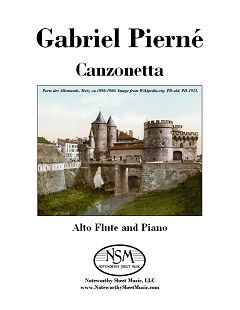 Canzonetta, Op.19, by G. Pierné
Canzonetta, Op.19, by G. PiernéTranscribed for Alto Flute and Piano by C.A.Vater
Piano Score and Alto Flute Part, PDF $6.99
Gabriel Pierné composed his Canzonetta for clarinet and piano (Op.19) in 1888, and it is among his most charming lighter works. The number of commercial recordings of the piece attest to its enduring popularity, extending into the modern era. Pierné dedicated this short, cheerful little song to his friend Charles Turban (1845-1905), the French clarinetist and professor of clarinet at the Paris Conservatory. The main melody is bouncy and gay, and brings merriment to players and audiences alike. Others have created transcriptions for alto sax and for flute. The piece is just as delightful when played on alto flute, and we now offer our new edition for alto flute and piano. Canzonetta would make a great encore piece for a concert or recital.
Alto Flute Part, 2 pages; Piano Score, 5 pages; Total, 10 pages.
Preview -
Scriabin - Romance - Transcribed for Clarinet, Flute, or Alto Flute
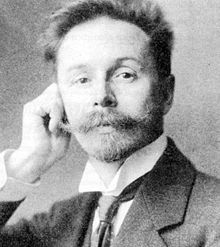 Romance, by Alexander Scriabin
Romance, by Alexander ScriabinTranscribed for Clarinet or Flute or Alto Flute (and Piano) by J. W. Pratt
Parts, PDF $0.00
Alexander Scriabin (1872-1915), the mystic Russian composer with music to match, wrote nine mind-bending orchestral works and myriad mostly miniature piano pieces. He began as a "Russian Chopin" and ended planning a week-long "Mysterium" to be performed in the Himalayas using "an orchestra, a large mixed choir, an instrument with visual effects, dancers, a procession, incense, and... mists and lights" (Wikipedia).
The Romance of 1890, his only chamber work except one variation for string quartet, is nearer the Chopin end of that spectrum, though the piano part adds harmonic and rhythmic complexities not evident from the solo part alone.
- John W. Pratt, Jan. 19, 2016
Please click on the links to download your free PDFs:
Transcription for clarinet required no changes of pitch. Scriabin - Romance - Clarinet
The transcription for flute is raised an octave, except the last five measures. Scriabin - Romance - Flute
The transcription for alto flute raises MM21-24 and MM36-48 an octave. Scriabin - Romance - Alto Flute
The piano score is freely available on IMSLP.org.
Scriabin image courtesy of Wikimedia.org, PD-old.
-
Bridge – 4 Short Pieces – Flute or Alto Flute (and Piano)
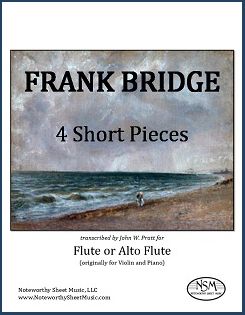 4 Short Pieces, by Frank Bridge
4 Short Pieces, by Frank BridgeTranscribed for Flute or Alto Flute (and Piano) by J.W.Pratt
Flute Part, Alto Part, PDF $8.99
The 4 Short Pieces by Frank Bridge were written for violin and piano, and first published in 1912. As noted in John Pratt's foreword to the edition, they "provide a fine and delightful introduction to an accessible post-romantic composer who should be better known." The pieces are "Meditation", "Spring Song", "Lullaby", and "Country Dance". Mr. Pratt has created transcriptions of the violin parts for both flute and alto flute, and we include both instrument versions in this edition. We think Nos. 1 and 3 sound particularly nice on the alto flute and No. 4 is a splendid romp on the C flute, but all four are effective on either instrument, so we prefer to let our flutists decide on which instrument they choose to play each piece. We provide only our flute and alto flute transcriptions; the piano score, including the original violin part, is available as a free pdf download at imslp.org.Flute part, 5 pages; Alto Flute part, 5 pages; Total, 14 pages.
Preview
-
Hauptmann - Bereavement - Alto Flute & Piano
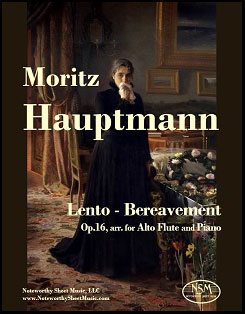 Lento - Bereavement, by Moritz Hauptmann
Lento - Bereavement, by Moritz HauptmannTranscribed for Alto Flute and Piano by C. A. Vater
Piano Score and Alto Flute Part, PDF $3.99
Hauptmann's 3 Violin Duos, Op.16 were first published in 1832. The Lento (Bereavement) from Op.16 later was arranged for violin and piano by the renowned violinist, violist, and composer Heinrich Wilhelm Ernst. It is this arrangement by Henri Ernst, published in 1880, that served as the basis for NSM’s transcription of the piece for alto flute and piano. The mournful simplicity of the Lento is perfectly captured and beautifully rendered by the alto flute.Alto Flute part, 1 page; Piano Score, 2 pages; Total, 6 pages.
Preview
-
Debussy - Première Rhapsodie - Alto Flute
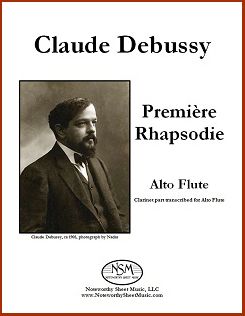 Première Rhapsodie, by Claude Debussy
Première Rhapsodie, by Claude DebussyTranscribed for Alto Flute by C.A.Vater, with a Foreword by P.H.Bloom
Alto Flute Part ― PDF $5.99
Since its introduction as a morceau de concours for the Paris Conservatoire in 1910, Debussy's Première Rhapsodie has been an essential piece of the clarinet repertoire.... Although most of the morceaux are, by definition, run-of-the mill exercises of virtuosity à la mode, a number have endured as works of significant musical merit. Debussy's Première Rhapsodie is one such piece. It's a vehicle for expressive interpretation and artistry, with charm, warmth, passion, and humor; a lasting treasure at the core of every clarinetist's collection of indispensable works.... But a transcription? Of a work by Debussy - the great colorist of instrumental sonority? From clarinet to alto-flute?... Each and every element, in fact, evokes the alto-flute!... Of course the piece sounds different on the two instruments. Although the sonic hues are different, the colors are just as vivid. The distinct sonorities of the alto-flute support the nuance, the affect, and the power of the work. (excerpted from Peter H. Bloom © 2012)
We provide our alto flute part only; appropriate parts for piano or orchestral accompaniment may be obtained as free pdf downloads from public domain resources, such as imslp.org.
Alto Flute part, 4 pages.
Preview -
Elgar – Salut d’Amour – Alto Flute & Piano
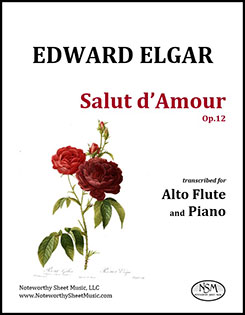 Salut d’Amour, Op. 12, by Edward Elgar
Salut d’Amour, Op. 12, by Edward ElgarTranscribed for Alto Flute and Piano by C. A. Vater
Piano Score and Part for Alto Flute, PDF $6.99
The English composer Edward Elgar held many positions throughout his career, including those of organist at St. George’s Roman Catholic Church in Worcester, conductor of the Worcester Philharmonic, Professor of Music at the University of Birmingham, and conductor of the London Symphony Orchestra. He achieved considerable prominence as a result of his many successful orchestral, vocal, and chamber music compositions. Elgar composed this piece in 1888, as an engagement gift to his beloved future wife. Though first written for piano solo, arrangements were created shortly thereafter by the composer himself for violin and piano, and for orchestra. Originally titled “Liebesgruss” (Love’s Greeting), but later changed to Salut d’Amour, the piece is now one of Elgar’s most widely recognized works, and its immense popularity has led to arrangements for a wide variety of other instruments. We provide here a transcription of Salut d’Amour for alto flute and piano, which has been adapted from the editions published by Schott for violin and piano, oboe and piano, or orchestra and which are now in the public domain.
Score, 4 pages; Alto Flute part, 2 pages; Total, 10 pages.
Preview
-
Bridge – 4 More Short Pieces – Flute or Alto Flute (and Piano)
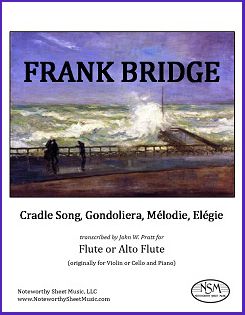 Cradle Song, Gondoliera, Mélodie, and Elégie, by Frank Bridge
Cradle Song, Gondoliera, Mélodie, and Elégie, by Frank BridgeTranscribed for Flute or Alto Flute (and Piano) by J. W. Pratt
Preview
Flute Part, Alto Part, PDF $11.99
Like the 4 Short Pieces for Violin and Pianoforte published in transcription by Noteworthy Sheet Music earlier this year, these additional four short pieces by Bridge "provide a fine and delightful introduction to an accessible post-romantic composer who should be better known." Published by Bridge between 1903 and 1911, the works included in our second edition are transcriptions of Cradle Song, written for violin or cello and piano, Gondoliera for violin and piano, and Mélodie and Elégie for cello and piano. Mr. Pratt has created transcriptions of all four pieces for both flute and alto flute, and we include both instrument versions in this combined edition. We think Cradle Song and Elégie are particularly beautiful on the alto flute, but all are effective on either instrument, so we prefer to let our flutists decide on which instrument they choose to play each piece. We provide our flute and alto flute parts only; the original piano scores work well with our transcriptions and are available, along with the violin and cello parts, as free pdf downloads at imslp.org—click the links to access the scores for Cradle Song, Gondoliera, Mélodie, and Elégie.
Flute part, 6 pages; Alto Flute part, 6 pages; Total, 14 pages. -
Elgar – Mot d’Amour – Alto Flute & Piano
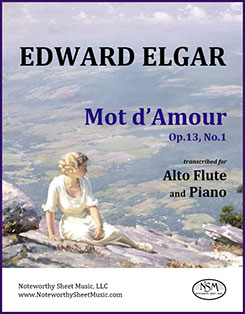 Mot d’Amour, Op.13, No.1, by Edward Elgar
Mot d’Amour, Op.13, No.1, by Edward ElgarTranscribed for Alto Flute and Piano by C. A. Vater
Piano Score and Part for Alto Flute, PDF $5.49
In 1888, Elgar composed Salut d’Amour, now one of his most-recognized pieces, as an engagement gift for his beloved fiancée. Later he wrote Mot d'Amour (Love's Word) for violin and piano as a companion piece to Salut d’Amour. Mot d'Amour, which was initially given the German title Liebesahnung, was published in 1889 by Osborn & Tuckwood in the edition 2 Pieces for Violin & Piano that included this piece and a second one, less well-suited to alto flute, called Bizarrerie. Mot d’Amour is similar to Salut d’Amour in being light, charming, and highly romantic. Although Mot d’Amour never attained the level of popularity achieved by the earlier work, it is considered by some to be the finer composition (https://www.elgar.org/3salut.htm). Both Salut d’Amourand Mot d'Amoursound especially rich and mellow when performed on alto flute, and both pieces are now available from Noteworthy Sheet Music as transcriptions for alto flute and piano, adapted from the composer’s violin and piano editions now in the public domain and available on imslp.org.
Score, 4 pages; Alto Flute part, 1 page; Total, 8 pages.
-
Mozart - Concerto in E-flat major, K417 - Alto Flute & Piano
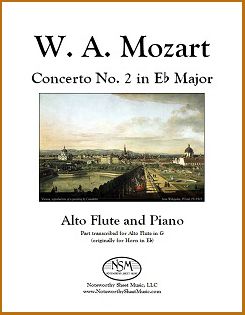 Concerto No.2 in E-flat major, K.417, by W. A. Mozart
Concerto No.2 in E-flat major, K.417, by W. A. MozartTranscribed for Alto Flute (from horn and piano arrangement) by C.A.Vater
Piano Score and Alto Flute Part, PDF $9.99
Mozart wrote his Concerto No. 2 in E-flat major for Horn and Orchestra for his good friend, the virtuoso horn soloist Joseph Leutgeb (c.1745-1811), who became first horn in the orchestra of the Salzburg archbishop in 1770. The concerto was completed in 1783. Its movements are light, joyous, and teeming with melody: a wide-ranging opening allegro, a slow middle movement, and a final rondo. The second movement Andante is particularly lyrical and beautiful, whereas the concluding Rondo is quite comic with an obvious hunting theme.
The concerto was arranged for horn and piano by Henri Kling (1842-1918), horn player, composer, conductor, and professor. We used the Kling arrangement, which was published ca.1890 and is now in the public domain, as the basis of our transcription of the concerto for alto flute and piano. We introduced only minor changes to the solo horn line to adapt it for alto flute, and those alterations were made with sensitivity and the intention of preserving Mozart's inspired creation to the fullest extent possible.
Alto Flute part, 4 pages; Piano Score, 16 pages; Total, 22 pages.
Preview -
Tchaikovsky - Arab Dance - Alto Flute & Harp/Piano
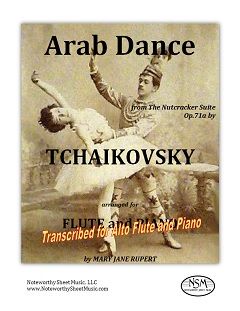 Arab Dance, by P. Tchaikovsky
Arab Dance, by P. TchaikovskyArranged for Flute and Harp or Piano by Mary Jane Rupert
Transcribed for Alto Flute by C.A.Vater
Alto Flute Part and Harp or Piano Score, PDF $7.99
Mary Jane Rupert's arrangement of The Nutcracker for flute and harp or piano includes all of the pieces from the original Suite, Op. 71a, except the Overture. Dr. Rupert stayed as close as possible to the original orchestration, in terms of key, harmony, register, and color. Originally published in 1988, the arrangement was re-edited by Dr. Rupert in 2013 for publication as separate flute/piano and flute/harp editions by Noteworthy Sheet Music. After creating the new flute editions, Noteworthy Sheet Music's editors realized that one of the pieces of the suite in particular, Arab Dance, would work beautifully on alto flute. We created an alto flute transcription of the flute part, both for ourselves and for our alto flutist friends.
We offer separate versions of the score for piano or harp, although in the case of the Arab Dance the harp-specific notation is minimal compared to some of the other pieces contained in the complete edition of The Nutcracker arranged for flute and harp.
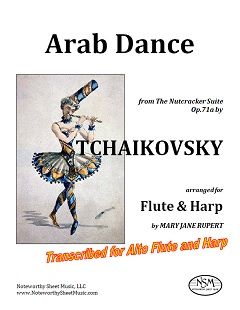 Alto Flute & Harp Edition: Harp score, 6 pages; Alto Flute part, 1 page; Total, 10 pages. $7.99
Alto Flute & Harp Edition: Harp score, 6 pages; Alto Flute part, 1 page; Total, 10 pages. $7.99
Preview Alto Flute & Piano Edition: Piano score, 6 pages; Alto Flute part, 1 page; Total, 10 pages. $7.99
Alto Flute & Piano Edition: Piano score, 6 pages; Alto Flute part, 1 page; Total, 10 pages. $7.99
Preview